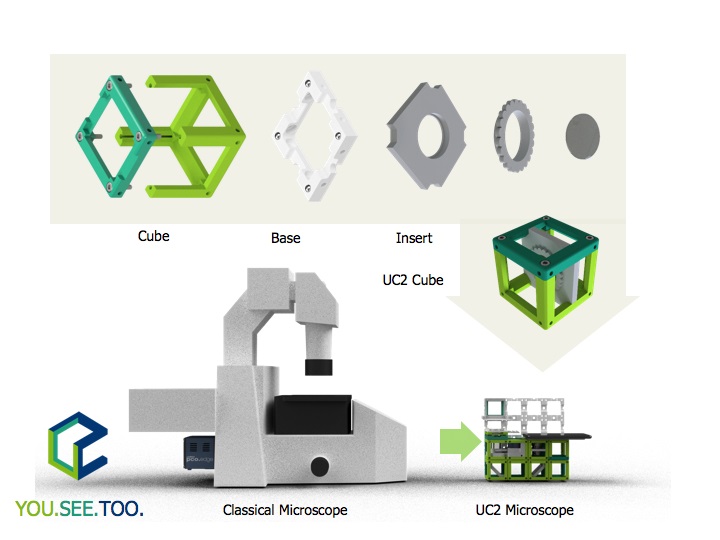Researchers from the Leibniz Institute of Photonic Technology (Leibniz IPHT), Friedrich Schiller University, and Jena University Hospital developed a low-cost modular microscope that has the potential to greatly expand access to high-resolution microscopic imaging technology.
The basic building block of the system, the UC2 (You See Too), is a 3D-printed cube with an edge length of 5 cm that can host a variety of components including lenses, LEDs, and cameras.

The open-source 3D-printed cube can host self-designed inserts and electrical and optical components. The resulting modules can be combined to form complex optical instruments. Courtesy of UC2.
The device's modular nature enables adaptability to the needs of specific research, said Leibniz IPHT Ph.D. student Benedict Diedrich.
“With our method,” he said, “it is possible to quickly assemble the right tool to map specific cells. If, for example, a red wavelength is required as excitation, you simply install the appropriate laser and change the filter. If an inverted microscope is needed, you stack the cubes accordingly.”
Low cost and easy reproducibility are other advantages of the device, Diedrich said. “Commercial microscopes that can be used to examine pathogens over a longer period of time cost hundreds or thousands of times more than our UC2 setup. You can hardly get them into a contaminated laboratory from which you may not be able to remove them because they cannot be cleaned easily.”
The researchers published construction plans and software on GitHub, a freely accessible online repository, so that the open source community can access, expand, and modify the presented systems.
“With the feedback from users, we improve the system step by step and add ever-new creative solutions,” said René Lachmann, a Ph.D. student at Leibniz IPHT who helped develop the system.
Another benefit of the modular system is the ability to teach simple optical concepts to generate student interest in optical science. To that end, the researchers developed a sophisticated tool set for educational purposes in schools and universities: With “The Box,” UC2 introduces a kit that enables users to learn about and try out optical concepts and microscopy methods.
“The components can be combined to form a projector or a telescope; you can build a spectrometer or a smartphone microscope,” said Barbora Maršíková, who developed experiments and a series of ready-to-use documentations that the UC2 team has tested in a number of workshops.
“We want to make modern microscopy techniques accessible to a broad public and build up an open and creative microscopy community,” Diedrich said.
The research was published in Nature Communications (www.doi.org/10.1038/s41467-020-19447-9).